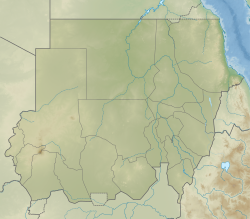
Back النقعة Arabic Нака (Судан) Byelorussian Temple de Naga Catalan Naqa German Naqa Spanish Naga (Sudan) Finnish Naqa French Naqa ID Naqa Italian Naqa Dutch
 The Roman Kiosk and the Temple of Apedemak | |
| Alternative name | Naqa |
|---|---|
| Location | Naqa, River Nile, Sudan |
| Region | Nubia |
| Coordinates | 16°16′10″N 33°16′30″E / 16.26944°N 33.27500°E |
| Type | Sanctuary |
| Official name | Archaeological sites of the Island of Meroe |
| Type | Cultural |
| Criteria | ii, iii, iv, v |
| Designated | 2011 (35th session) |
| Reference no. | 1336 |
| Region | Africa, Modern day Sudan |
Naqa or Naga'a (Arabic: ٱلـنَّـقْـعَـة, romanized: An-Naqʿah) is a ruined ancient city of the Kushitic Kingdom of Meroë in modern-day Sudan. The ancient city lies about 170 km (110 miles) north-east of Khartoum, and about 50 km (31 miles) east of the Nile River located at approximately MGRS 36QWC290629877. Here smaller wadis meet the Wadi Awateib coming from the center of the Butana plateau region,[1] and further north at Wad ban Naqa from where it joins the Nile. Naqa was only a camel or donkey's journey from the Nile, and could serve as a trading station on the way to the east; thus it had strategic importance.
Naqa is one of the largest ruined sites in the country and indicates an important ancient city once stood in the location. It was one of the centers of the Kingdom of Meroë, which served as a bridge between the Mediterranean world and Africa. The site has two notable temples, one devoted to Amun and the other to Apedemak which also has a Roman kiosk nearby. With Meroë and Musawwarat es-Sufra it is known as the Island of Meroe, and was listed as a UNESCO World Heritage Site in 2011.[2]
- ^ "Naga Project (Central Sudan)". Poznań Archaeological Museum. Archived from the original on January 17, 2018. Retrieved January 17, 2018.
- ^ UNESCO Island of Meroe.

